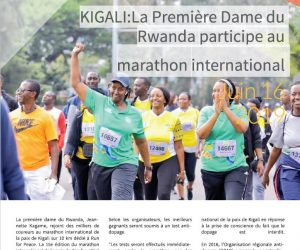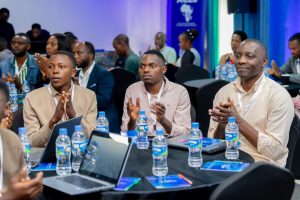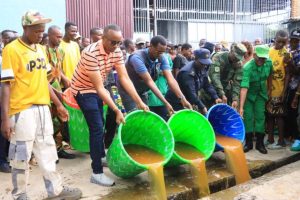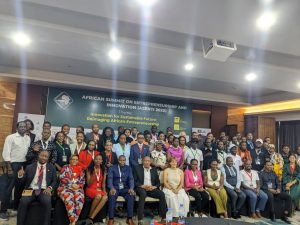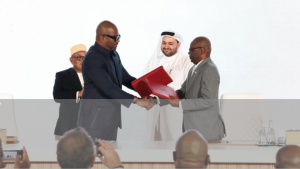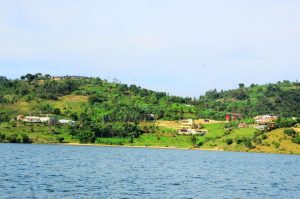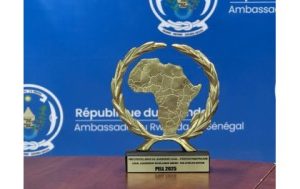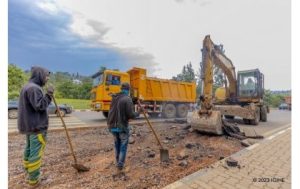Grant Writing & Resource Mobilization Training: Strategies for Media Houses and Local NGOs
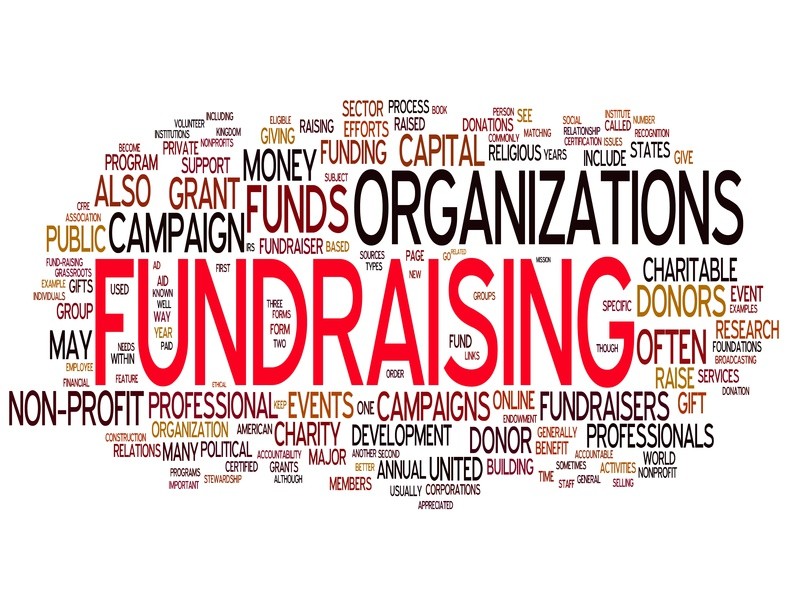
By Ange de la Victoire DUSABEMUNGU
Executive Summary
This report synthesizes the key insights and actionable strategies from the recent Grant Writing Training, held from September 15th to 17th, 2025, at the Kigali Paramount Hotel. The training, organized by the FOJO-Rwanda Media Programme (RMP), aimed to strengthen the capacity and sustainability of both media organizations and local Media Associations/NGOs in resource mobilization.
The sessions underscored a significant shift in the funding landscape, moving beyond traditional charity models towards public benefit activities. Central to success in this new environment is the cultivation of genuine relationships and robust networks with funders, which dramatically increases funding success rates from a mere 10-20% for open calls to 70-80% when contacts are established.
Key areas covered included understanding diverse funding models (grants, earned revenue, crowdfunding, patronage), the ethical considerations inherent in accepting funds, and the practicalities of crafting compelling proposals and managing budgets. Participants were introduced to digital tools for research and tracking, and explored innovative strategies like product development and community building for long-term sustainability. This report serves as a comprehensive guide to help organizations navigate these complexities and secure the resources needed to further their public interest missions.
1. Introduction to the Evolving Funding Landscape
The realm of fundraising for organizations dedicated to public benefit, including journalism and media, has undergone a profound transformation. The traditional “holding out the baby bowl” approach, common for orphanages and similar charities, is no longer the sole or most effective method. Today, there is a substantial amount of money available in the philanthropic and development sectors for organizations engaged in activities that serve the public interest.
Journalism and media organizations have increasingly been recognized as public benefit entities. This shift is primarily due to their diminishing access to traditional advertising revenue, which necessitates alternative means of sustaining their work. Consequently, many journalism organizations are now actively engaged in fundraising.
A paramount lesson from the training is that relationships are the cornerstone of successful fundraising. While numerous “open calls” for applications can be found online, the chances of success for such unsolicited applications are relatively low, estimated at around 20-25%. However, if an organization has an established contact within a funding body, someone who knows the organization and with whom a relationship has been built, the success rate skyrockets to 70-80%. This emphasizes that funders prefer to give to people they know and trust, making networking critically important.
Collaboration and synergy further amplify opportunities. Many organizations already operate within existing associations or “umbrella networks”. An example like Synergy, which comprises three different media organizations working together, illustrates a powerful model for expanding access to funding. By joining forces with other organizations doing similar work, entities can access more opportunities, receive referrals, and exchange ideas. While competition among similar organizations can be a challenge, transparency and openness are vital for successful partnerships.
2. Understanding Diverse Funding Models
The training highlighted that all funding, regardless of its source, comes with “strings attached”, requiring work, effort, and accountability. Therefore, organizations must strategically choose funding types that align with their inherent strengths and characteristics.
2.1. Crowdfunding and Small Donations: Organizations with a large online audience and a significant social media presence are well-positioned to secure funding through small donations or crowdfunding from their audience base. This approach leverages existing digital infrastructure and audience engagement. For media organizations, approaching a dedicated audience for larger donations from “high-net-worth individuals” can also be considered a form of patronage or gift. Crowdfunding campaigns are most effective when they are time-limited and focused on a specific, emotionally compelling cause, such as funding a school’s water well after a related news story.
2.2. Earned Revenue Streams: Organizations can monetize their skills and services to generate income, which often comes with fewer restrictions compared to grants.
- Events Management: Organizations, particularly those with logistical capabilities (e.g., radio stations with outside broadcast equipment), can offer event management services to companies and other community organizations. This generates income by providing a service for a fee. Additionally, NGOs can host fundraising events like gala dinners or concerts, where proceeds directly support their activities.
- Consulting Services: Staff expertise can be monetized by offering communication or media support to developmental organizations. This operates like a service provider agreement, where the organization charges for delivering a specific service or project.
- Memberships and Paywalls: For media houses with a dedicated and engaged audience, implementing membership schemes or paywalls can generate unrestricted income. This revenue, once in the bank, can be used flexibly for organizational needs, unlike restricted grant funds.
- Traditional Ad Revenue: Content monetization through platforms like YouTube can still generate advertising revenue.
3. Grants: Types, Requirements, and Strategic Considerations
Grants represent a significant funding source, but they come with specific structures and demands.
3.1. Organizational Grants: These involve relatively large sums of money designed to support the core operations of an organization. However, they are highly restricted. Applying for them requires detailed proposals, comprehensive budgets, and a clear outline of specific activities. Funds are tightly regulated according to the submitted budget, and adherence is mandatory even if circumstances change.
- Pros: Access to significant funding for organizational growth and the ability to pay staff.
- Cons: Rigorous financial and narrative reporting (monthly, quarterly, or yearly) is mandatory. Funding decisions are based on the strength, credibility, and legitimacy of the organization (e.g., having a board, CEO, and various staff members, not just a single individual operation). Importantly, organizational grants are typically for media organizations with specific developmental priorities (e.g., environmental journalism, work with people with disabilities), not general magazines or popular content.
3.2. Story/Project Grants and Fellowships: These grants are for specific projects or stories, rather than funding the entire organization. They can support various content types, from lifestyle and breaking news to investigative journalism. Many come with fellowship opportunities, awarded based on the strength and reputation of individual journalists with impressive CVs and extensive portfolios. Organizations with such journalists can apply for prestigious fellowships like the Pulitzer or Rogers Fellowships.
3.3. “Old School Proposals”: These refer to responses to specific calls for proposals issued by funders, often including fellowship applications for networks focused on particular areas like ocean reporting or environmental journalism.
3.4. Restricted vs. Unrestricted Funds: A critical distinction is that grant funds are restricted, meaning they must be used precisely according to the approved budget. The “work” of accountability and reporting often comes after the money is received. In contrast, earned income (from services, memberships, or donations) becomes unrestricted once in the bank, offering flexibility for organizational needs like salaries or office supplies.
3.5. Timeframes: The process from proposal submission to receiving funds can take several months, depending on the review process.
3.6. Application Strategies: While applying to open calls is encouraged, it’s important not to spend too much time on them due to the lower success rate (20-25%). Prioritizing relationship-building with funders significantly increases the chances of success (70-80%). For journalists in regions with “closed systems,” building these relationships can be particularly challenging.
4. Ethical Considerations and Power Dynamics in Funding
Maintaining integrity and independence is paramount, particularly for media organizations whose most valuable asset is the trust of their audience.
4.1. Understanding Funder Motivations: It is crucial to thoroughly research potential funders, especially wealthy patrons, to understand their motivations. Relying on a single patron creates vulnerability; if that support is withdrawn, the organization faces potential shutdown, as illustrated by a South African media house example. This due diligence helps align interests and prevent compromises to editorial independence.
4.2. Managing Power Dynamics: Donors are increasingly aware of the power imbalances in funding relationships and often prefer a more balanced partnership. Organizations should clearly communicate their situation, needs, and what they are willing to do, taking ownership rather than simply complying with imbalanced conditions.
- Service Provision vs. Donation: Organizations must differentiate between situations where a funder is asking for a service (where the organization sets its rates, like for marketing or ad space) and where they are offering a donation (which might come with imposed conditions). The training suggested converting donations into service provider agreements where possible, to ensure the organization’s time is compensated and some funds remain for core operations, avoiding merely acting as a “financial conduit”.
4.3. Ethical Boundaries and Saying “No”: It is vital for organizations to be ready to decline funding if it compromises their values, mission, or editorial independence. This can be difficult, especially when in need of funds, but prioritizing long-term integrity is crucial.
- Fundraising Policy: Organizations, particularly umbrella networks like Synergy, should develop a clear, written, and publicly available fundraising policy. This policy acts as a shield, protecting the organization from detractors who might try to discredit its work based on funding sources. It also ensures consistent decision-making, rather than arbitrary choices.
- Transparency of Donors: Publicly disclosing major donors (e.g., those contributing $5,000 or more per year, or those providing over 50% of the annual budget) is a powerful act of transparency. This proactively demonstrates independence and builds audience trust, signaling that no single donor has undue influence.
- Cultural and Political Nuances: Organizations must navigate cultural sensitivities (e.g., different perspectives on child labor) and political considerations when crafting proposals, especially for international funders. For example, when applying to politically balanced boards like the National Endowment for Democracy (NED), tailoring proposals to a centrist or slightly right-leaning perspective, avoiding overtly progressive stances, can increase success.
5. Crafting Effective Proposals
A well-constructed proposal is more than just a request for money; it’s a strategic document that reflects an organization’s capacity, vision, and alignment with a funder’s priorities.
5.1. The Budget as an Integral Part: The budget is not merely an attachment but an integral part of the proposal, requiring careful construction to fit what the donor is looking for.
- Donor Guidelines: Always consult the donor’s website or budget template for detailed notes on inclusions and exclusions (e.g., conference fees, salaries, indirect costs).
- Indirect Costs/Overheads: Most donors cap indirect costs (overhead, administrative expenses) at 10-15% of the total budget. It is strategic to find ways to incorporate these essential costs, often by labeling them as contingency, project management, financial management, or monitoring & evaluation (M&E), as funders are typically more receptive to covering these.
- Core Costs: Do not overlook including basic core costs like salaries, rent, and internet in the budget, as these are often forgotten but essential for operations.
5.2. Demonstrating Existing Funding & Sustainability: Donors often request information on other funding sources. This is primarily to assess the organization’s sustainability and reduce their risk of being the sole donor. Funders generally prefer not to fund more than 30-50% of an organization’s total annual budget. It is advisable to present a budget that shows existing funding and then highlights a “shortfall”—the amount still needed for planned activities—to clearly demonstrate the need for the grant.
5.3. Organizational Capacity & Proximate Leadership: Proposals must detail the organization’s structure, including board members, leadership, and key staff. A growing trend among donors is the emphasis on “proximate leadership,” meaning leaders who have a direct, lived experience related to the project’s beneficiaries. This “for us by us” approach ensures that the leadership is closely connected to the real needs on the ground.
5.4. Standard Proposal Sections: A comprehensive proposal typically includes:
- Cover Letter and Executive Summary: Brief introduction and overview of goals.
- Organizational Background and Problem Statement: Mission, experience, and the issue addressed.
- Project Objectives, Methodology, Activities, and Timeline: Specific, measurable goals and how they will be achieved, including deliverables.
- Expected Outcomes & Impact: The anticipated change or benefits.
- Partnerships & Beneficiaries: Highlight collaborations and direct community involvement.
- Budget & Financials: Detailed budget, showing existing funding and gaps.
- Monitoring & Evaluation (M&E): How success will be measured.
- Sustainability: How the project will continue post-grant.
- Gender & Climate Mainstreaming: Increasingly required sections detailing how gender equality and environmental sustainability are integrated.
5.5. Service Provider Proposals: When submitting proposals for consulting or service provision, the focus shifts to staff skillset, CVs/bios, previous experience, and references. A “rate card” detailing costs for services (e.g., daily rates for consultants or venue rental fees) is highly recommended as it builds confidence and streamlines negotiations.
6. Tools for Research and Tracking Funding Opportunities
Effective fundraising necessitates systematic research, tracking, and management of opportunities. The training emphasized leveraging collaborative digital tools to streamline these processes.
6.1. Collaborative Digital Tools: Organizations are encouraged to utilize Google Suite products (Docs, Sheets, Drive) for team collaboration on proposals and tracking. These shared platforms are crucial for managing multiple prospects and avoiding duplicated efforts.
- Project Trackers: A shared Google Sheet can serve as a project tracker, with columns for potential donors, contact details, project specifics, and the stage of interaction (e.g., prospect, secured lead, pitching, proposal sent, unsuccessful). An important column is “solicited or unsolicited”, as data shows unsolicited proposals have a lower success rate.
- Benefits: Such trackers provide immediate access to information, prevent delays caused by manual requests, and enhance coordination among team members working on different opportunities.
6.2. Key Websites and Resources for Funding Research: Participants were introduced to various platforms for identifying funding opportunities:
- General Grant Databases: Websites like “Figure Out Opportunities,” “Funds for NGOs,” and “Digital Funders & Project Databases” allow users to search and filter opportunities. Subscribing to their free newsletters is highly recommended for receiving updates.
- Foundation & Grant Mapping Platforms: Foundation Maps by Candid is a useful tool for searching and identifying prospective donors.
- Media-Specific Resources:
- Google Grants: For media organizations, often region and content-specific.
- Institute for Nonprofit News (INN): Based in the US, specifically for news organizations seeking grant funding.
- News Fuel: Provides updates on open and closing grants, helping to prioritize timely applications.
- Global Fund for Media & Development (GFMD): Another resource for media-focused grants.
- Regional-Specific Platforms: Explore opportunities tailored to Africa or specific sectors.
6.3. CRM and Project Management Tools: Beyond basic spreadsheets, investing in Customer Relationship Management (CRM) or robust project management systems becomes crucial when managing more than two or three grants simultaneously.
- Notion: A versatile, free platform that integrates CRM, note-taking, project management, and resource libraries. It can provide a visual pipeline of donors at various stages (prospect, proposal, negotiation, approved, implementation).
- Salesforce (Nonprofit Version): A paid but discounted option specifically designed for grant management and donor relations in the nonprofit sector.
- Monday.com: Another powerful project management tool with CRM functionalities, though access might be restricted in some regions.
- Automation: These systems can automate reminders for reporting deadlines, follow-ups, and contract renewals, sending alerts to responsible team members. This significantly reduces the risk of missed deadlines and ensures compliance.
7. Budgeting Best Practices and Financial Management
Effective budget preparation and financial management are crucial for successful grant acquisition and project implementation.
7.1. Aligning Budget with Donor Requirements: The budget must always align with the donor’s specific guidelines, including what costs they permit or exclude. Some donors, like NED, may require specific breakdowns, such as separating taxes and allowances from total salary costs.
7.2. Project-Specific Budgets: Most grants require a budget that covers only the specific project for which funding is requested.
- Salary Allocation: Include salary costs for staff directly involved in the project, justifying the percentage of their time dedicated to project activities. Full salaries can be included for staff working 100% on the project, with clear justification.
- Indirect Costs: While direct project costs are preferred, a percentage (e.g., 10-25%) for administrative or overhead costs can be included for financial management, M&E, or project coordination.
- Consultancy/Service Provider Budgets: These are based on rate cards or daily rates for personnel (e.g., team leaders, specialists) for a specified number of days, plus associated costs like travel, accommodation, workshops, and printing.
7.3. Importance of an Annual Budget Context: Donors often want to see the project’s cost as a percentage of the organization’s total annual budget. This reassures them that they are not funding more than a sustainable proportion (e.g., typically not more than 30-50%) of the organization’s overall operations, reducing the risk of dependency.
7.4. The “Money In, Money Out” Pitfall: A common challenge is when an organization acts solely as a “financial conduit”—receiving funds that are immediately disbursed to service providers, without adequate compensation for its own time or administrative costs. To counter this, organizations should aim to convert such arrangements into service provider agreements, ensuring their time is compensated and some funds remain within the organization.
7.5. Managing Unspent Funds and Reallocation: Grant funds are expected to be spent as budgeted. Unspent funds typically must be repaid to the donor. If budget lines are expected to vary by more than 10%, it is crucial to proactively communicate with the donor and request a reallocation. Donors value clear communication and active financial management.
7.6. Rigorous Reporting and Audits: Grant management involves significant work post-award, including regular financial and narrative reporting (often quarterly) and sometimes a project-specific audit. These activities must be factored into the budget and workload, as they represent a real cost to the organization. Thoroughly reading grant contracts before signing is essential to understand all reporting obligations, audit requirements, and any specific conditions attached to the funds.
8. Maximizing Opportunities: Innovation, Collaboration, and Advocacy
Beyond traditional grant applications, organizations can strategically innovate and collaborate to enhance sustainability and impact.
8.1. Collaboration as a Core Strategy: Collaborative investigative journalism, such as cross-border reporting by organizations like CIJA, amplifies reach and impact. Partnering with other organizations, even those globally, enables access to diverse expertise and broader audiences. Community building through membership networks fosters further collaboration, resource sharing, and professional development.
8.2. Product Development for Sustainability: Organizations can monetize their work by developing innovative products or services, reducing sole reliance on donor funding.
- Gamification of Journalism: Engaging younger demographics by turning investigative stories into interactive video games (e.g., “Shoot Your Vote”) can educate and raise civic awareness more effectively than traditional articles. This approach can eventually be commercialized to generate revenue.
- AI Tools for Journalists: Developing tools like “Election Watch,” an AI-powered platform for tracking social media narratives during elections, provides a valuable service that can be monetized through subscriptions after an initial free period.
- Specialized Training Programs: Internal training expertise can be monetized by offering workshops and sessions to other media organizations, nonprofits, or individual journalists. Collaborating with partners like Google or journalism AI can secure funding for these training initiatives.
8.3. Strategic Philanthropy and International Access:
- Matching Campaigns: Participating in fundraising campaigns like “NewsMatch” (e.g., by the Institute for Nonprofit News) can significantly boost private donations, where external funds match individual contributions.
- Establishing International Affiliates: Organizations can explore establishing a foundation or affiliate in countries like the US or UK to access a broader pool of donors, particularly those requiring certifications like the 501(c)(3) tax exemption or its equivalency. This requires careful consideration of legal and compliance requirements, including how foreign funding limits might apply.
9. Conclusion and Next Steps
The Grant Writing Training provided a robust framework for media houses and local NGOs to navigate the complex funding environment. Successful resource mobilization requires a multifaceted approach: building strong relationships, diversifying income streams, adhering to ethical standards, and leveraging effective tools.
To ensure long-term sustainability and maximize impact, participants are encouraged to implement the following next steps:
- Conduct a SWOT Analysis: Regularly assess organizational Strengths, Weaknesses, Opportunities, and Threats to inform strategic planning and fundraising efforts.
- Develop a Clear Fundraising Policy: Create a publicly accessible policy that outlines ethical guidelines for accepting funds, types of donors accepted/rejected, and transparency commitments. This protects editorial independence and organizational integrity.
- Implement Digital Tools for Tracking: Utilize shared spreadsheets or CRM systems (e.g., Notion, Salesforce, Monday.com) to systematically track potential donors, manage application stages, monitor deadlines, and automate reminders for reporting. This improves efficiency and coordination.
- Prioritize Relationship Building: Actively engage with potential funders, attend networking events, and nurture existing contacts. Direct relationships significantly increase funding success rates.
- Diversify Income Streams: Explore a mix of funding models including grants, earned revenue (consulting, events, memberships), crowdfunding, and product monetization to avoid over-reliance on a single source and enhance resilience.
- Master Proposal & Budget Crafting: Tailor each proposal meticulously to the specific funder’s priorities, guidelines, and political sensitivities. Ensure budgets are realistic, justify all costs, factor in overheads, and demonstrate organizational sustainability.
- Understand Contractual Obligations: Read grant contracts thoroughly to comprehend all reporting requirements, audit obligations, and conditions attached to funds. Proactive financial management and communication with donors are key to compliance.
- Innovate and Collaborate: Invest in developing new products or services from core activities (e.g., gamified journalism, AI tools, specialized training) and seek collaborations to expand reach, share resources, and create new revenue streams.
By adopting these strategies, media houses and local NGOs in Rwanda can bolster their capacity to secure sustainable funding, enabling them to continue their vital work in serving the public interest and driving positive social change.

SUBSCRIBE TO OUR NEWSLETTER

